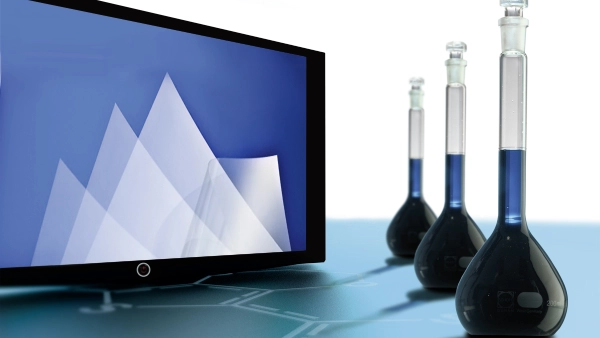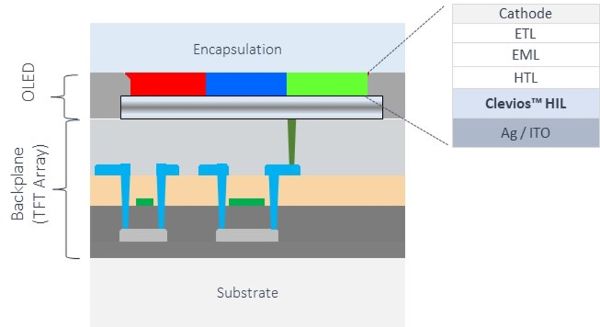OLED and QLED Displays
OLED (Organic Light Emitting Diodes) and QLED (Quantum-Dot Light Emitting Diodes) technologies are central to the development of flexible and foldable displays used in devices such smartphones, tablets, and wearables – making thinner, lighter, more energy-efficient and more powerful products possible. Clevios™ HIL materials improve the performance and processing of OLED displays – while also making them more cost-effective.

OLED and QLED in display technology
OLED displays are made by placing a series of organic thin films between two conductors. When an electrical current is applied, a bright light is emitted. Since the materials used for OLEDs are organic compounds, they are inherently flexible. This makes OLED displays an excellent choice for creating flexible and foldable screens. OLED screens can bend without the performance being affected, which allows them to be used in devices with various form factors, like folding smartphones or curved monitors.
The organic layers of an OLED can be made on a flexible substrate, which means that the display can be bent or folded. OLED panels can be very thin and do not require a backlight, unlike traditional LCD screens, which makes them ideal for flexible designs. OLED displays also offer high contrast ratios, deep blacks, and a wide color gamut because individual pixels emit their own light and can be turned off completely for pure black.

QLED is a term often used to describe LED displays that use quantum dots to enhance performance in key picture quality areas. The quantum dots are nano-sized particles that emit light in a specific wavelength when hit by light, which means they can produce extremely accurate colors. Although traditional QLED TVs are not flexible, newer developments are starting to incorporate quantum dots into flexible displays.
Quantum dots can improve the color accuracy and vibrancy of displays without compromising efficiency. They can achieve higher peak brightness levels which can be more efficient in terms of energy consumption. While the current mainstream QLEDs are not flexible, there is ongoing research to combine quantum dot technology with flexible substrates.
4 Results
Name | Product Description | Type | Sheet Resistance Range | Printing or Coating Method | Application | |
|---|---|---|---|---|---|---|
| Clevios™ HIL 8 | PEDOT-complex, dispersion in butylbenzoat, blue liquid | Formulation | > 10E6 Ohm/sq | Inkjet Printing | OLED Lighting, OLED / QLED Displays | |
| Clevios™ HIL JET 8 | PEDOT-complex, dispersion in butylbenzoat, blue liquid | Formulation | > 10E6 Ohm/sq | Inkjet Printing | OLED Lighting, OLED / QLED Displays | |
| Clevios™ P Jet (OLED) | PEDOT:PSS; Aqueous PEDOT / PSS dispersion, blue liquid | Formulation | > 10E6 Ohm/sq | Spin Coating, Wirebare Coating, Inkjet Printing | OLED Lighting, OLED / QLED Displays | |
| Clevios™ P VP Al 4083 | Aqueous PEDOT / PSS dispersion, blue liquid | Formulation | > 10E6 Ohm/sq | Spin Coating | OLED Lighting, OLED / QLED Displays, Organic Photovoltaics (OPV), Organic Photodetector (OPD), |